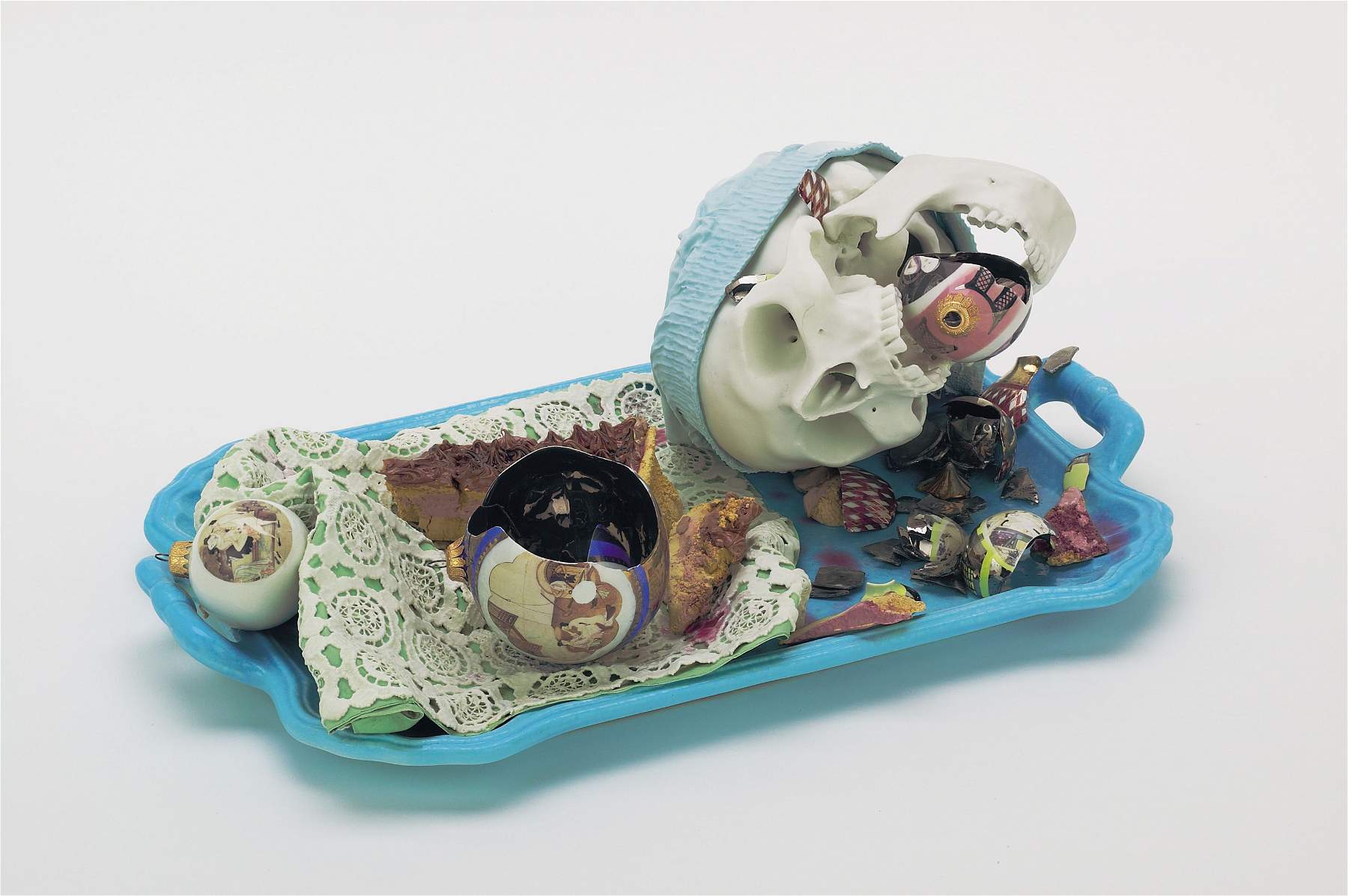In many of Bertozzi & Casoni’s works, one comes across objects that are avowedly “made of ceramics”: plates, cups, teapots where the ceramic explicitly declares itself amidst a clutter of other objects. Ceramics is a protean material. It is the world champion of imitation. Like the god Proteus described by Ovid, it can take organic and inorganic forms, animal and vegetable: Proteus becomes at will boy, lion, boar, snake, bull, stone, plant, water, river, fire. Bertozzi & Casoni’s ceramics become metal coffee table, octopus, coffee, plastic ashtray, cigarette packet, cigarette filter, ash, tin foil, photo roll, cream cake, worn out candle, unlit wick, toucan, fruit box, parrot, box, plastic bag, banana peel, grasshopper, denture, cockroach, paper bag, acorn, live squirrel, plucked chicken, knife, fawn, stone block, stork, twigs, dollars, batteries of’car, mushrooms, bin, cocker, butterflies, excrement stew, suitcases, gorilla, file, magazine, dishwasher’s glove, canned goods, rope net, ice, snow, white bear, human shin. But here, in its ability to imitate anything, ceramics also runs into imitation of itself: plates, saucers, cups, teapots are a recurring presence in Bertozzi & Casoni’s works.

The incessant metamorphic versatility of ceramics triggers an ambivalence, an uncertainty in perception: what are we looking at? A pile or a single object? An aggregate or a unitary block pretending to be polymateric and plural? Bertozzi & Casoni’s hyperreality is both classical and anticlassical: classical in its respect for the limit, for the contour, for the perspicuous, accurate, infinitesimal, stubborn representation; anticlassical because, under those lines, beyond those boundaries, it is always the same matter that dilutes, that overflows, that continues. It is always the same ceramic flowing under the form, piercing from one object to another. These considerations of mine, it must be said, do honor and at the same time wrong the art of Bertozzi & Casoni. Honor to their mastery, wrong to their visionarity, because they trace it back to the material they use, and to technical skill. I mean that, for example, in painting, it would not occur to any art critic to take into consideration, or rather to take inside in his interpretative discourse, the fact that, in a painting, to become from time to time tree, sky, incarnate, cloth is always the same pigmented oily paste spread by the brush, first fluid and then dried on the canvas or board; it is an implicit and acquired fact, it is part of the rules of the game of painting: oil or acrylic color does not fuel hermeneutic speculation. And yet it cannot be denied that the material virtuosity, the imitative acrobatics, the metamorphic dizziness of ceramics is an element of Bertozzi & Casoni’s art that one cannot pretend to ignore. Indeed, the gaze of anyone who stands before one of their works always also contains a quota of disbelief, of almost baroque astonishment. "Did they really manage to do all this with ceramics? Even this puny eggshell? Really?"
Admiration for technical virtuosity is part of the look with which their works should be received. It is only a part, let me be clear, but an inevitable and essential part. [...] You are amazed that everything you see is made of ceramics. In some cases you come to disbelieve it. Then you set out to look for it. To trace it, to recognize it. The questioning of matter, the verification of matter becomes one of the preponderant aesthetic experiences in the encounter with their work. At the opposite of glass, then, ceramics are in danger of putting themselves in the foreground precisely because they do everything they can not to put themselves in the foreground! One has to be careful, when looking at their works, that the amazing metamorphic and protean performance of matter does not steal all the scene through this paradoxical retreating from the scene. The concealment of matter is one of the technical, and philosophical, themes of their works.
---
Tiziano Scarpa, The Delicacy of Devastation, in Maurizio Caldirola, Daniele Sorrentino (eds.), Bertozzi & Casoni. The Lies of Art, exhibition catalog (Venice, Galleria Internazionale d’Arte Moderna di Ca’ Pesaro, June 6 to September 2, 2007), Damiani, Bologna, 2007, pp. 73-74
 |
| Supercult. Tiziano Scarpa on Bertozzi & Casoni |
Warning: the translation into English of the original Italian article was created using automatic tools. We undertake to review all articles, but we do not guarantee the total absence of inaccuracies in the translation due to the program. You can find the original by clicking on the ITA button. If you find any mistake,please contact us.